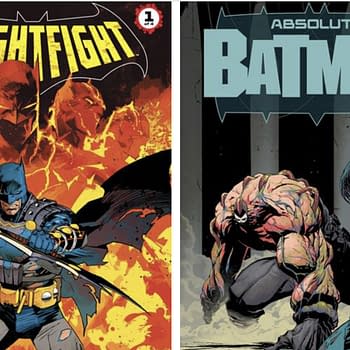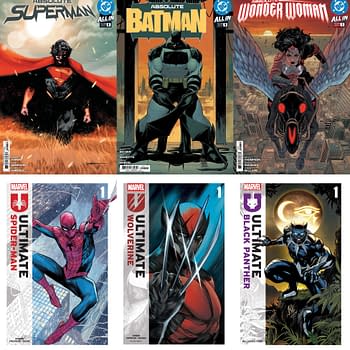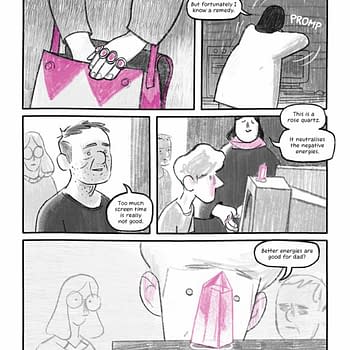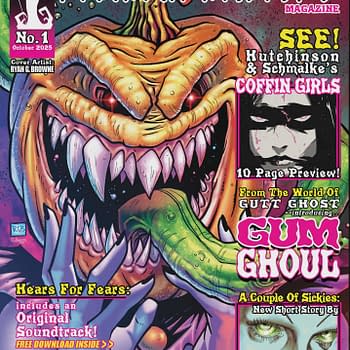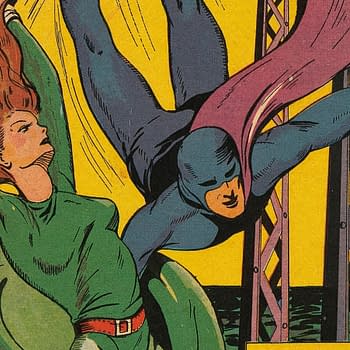Posted in: Comics, Recent Updates | Tagged: Comics, dc, entertainment, gendercrunching, marvel
Gendercrunching February 2016 by Tim Hanley – Women Writing Women
By Tim Hanley
Both DC and Marvel's overall percentage of female creators fell in February, with DC taking the bigger tumble and Marvel posting the higher percentage of the two. We also take a look at writers at the Big Two and which characters they're writing.
DC COMICS
After a solid start to the year in January, DC fell considerably this month. In February 2016, DC Comics released 77 new comics with 689 credited creators, 595 men and 94 women. Let's look at their stats:
DC's overall percentage of female creators dropped 2.4%, quite a noticeable slide. Usually we see some slight variations month to month, but this is an abnormally big swing. The only gains by category came from colorists and letterers, with the former gaining 4% and the latter more than 1%. Everything else fell, including a 5% drop for writers, a 4% drop for pencillers, and a nearly 5% drop for editors. The losses far outweighed the gains, leading to a surprisingly steep fall for DC overall.
The Past Year At DC: Looking back over the past year, February's showing is DC's lowest since last September:
Setting aside the abnormally high "Convergence" numbers from April and May, DC's female creator numbers have grown over the past year and leveled out at a comparatively decent number. February's total is low relative to the past few months, but next month will tell if this is a momentary blip or a shift in trend.
MARVEL COMICS
Marvel's overall percentage slipped down in February as well, but only slightly. In February 2016, Marvel put out 76 new comics with 649 credited creators, 551 men and 98 women. Here are the numbers:
Marvel's overall percentage of female creators dropped 0.6%, a fairly minimal decline with ups and downs across the board. Cover artists, pencillers, inkers, and colorists all posted slight gains, with colorists seeing the largest jump with an increase of nearly 3%. Letterers remained the same with yet another 0%, and the rest of the categories had losses, including a slight downturn for writers and drops of nearly 4% and 2% for editors and assistant editors. These shifts all combined for a small drop overall.
The Past Year At Marvel: Marvel's February total is roughly in line with their past few months:
While Marvel remains somewhat below their past highs, they've leveled out at a range that is comparatively quite strong for the publisher.
WHO THE WRITERS ARE WRITING
We've seen growth in the number of female creators at DC and Marvel over the past few years, particularly when it comes to female writers, but while doing this column each month I noticed a trend in who these women are writing. It looked like female writers were primarily writing female characters, so I decided to run some numbers to see who was writing who at the Big Two (we'll look at artists in a future column).
To do this, I looked back at the stats for every other month over the past year, starting with this February, and tabulated the numbers for each publisher's superhero titles (I left out licensed, non-superhero properties as well as Vertigo at DC and Icon at Marvel). I sorted the various issues and their writers into three categories: books with a male lead(s), books with a female lead(s), and team/mixed books with headliners of both genders. Thus sorted, I combined the data for all six months I examined and calculated the averages for a) how the books broke down by category overall, b) the numbers for male writers in each category, and c) the numbers for female writers in each category.
This methodology will become more clear when we take a look at the charts. Let's start with DC:
The green entries are DC's books overall. More than half of their titles are headlined by male characters, about 30% are team/mixed books, and only 18% have a female character in a starring role. The blue entries show the breakdown of who male writers are writing, and it's very comparable to the overall numbers, with each entry within a few percentage points of its corresponding pair overall. So basically, male writers at DC are writing characters roughly analogous with how the publisher's books break down overall.
Female writers, on the other hand, do not match the overall breakdown. The vast majority of women writing superhero books at DC are writing female characters, with only 19% writing male-led books and 12% writing team titles. It's a rather disproportionate breakdown, particularly in comparison to DC's line overall.
Furthermore, the percentage of books with a male lead written by women doesn't tell the whole story. Most of those books were released back in February and April with "Convergence" titles and comics that tied into the Arrow and The Flash television shows. None of those books come out any more. From October through February, the only male-led title with a woman at the helm was Ming Doyle co-writing Constantine: The Hellblazer.
Marvel's numbers are even more striking:
Much like with DC, the books written by male writers look a lot like Marvel's overall publishing line. This is in part because men write most of Marvel's publishing line, but also because men are given a wide array of titles. Women are not; over the six months I examined, not a single female writer wrote a comic with a male lead character, and 79% of the books that women wrote starred women. At both DC and Marvel, it seems that women are being pigeonholed into writing only women.
Now, there's nothing wrong with women writing women. In fact, after decades of only men writing women, it's a welcome change. But women are capable of writing more than just women, and they aren't doing so. Meanwhile, men are given a chance to write everyone. And here are some surprising numbers: Despite women writing female characters about 70% of the time at DC and 80% of the time at Marvel, there are still more men writing female characters at both publishers! At DC, men accounted for 56% of the writers on books with a female lead, while at Marvel they accounted for 59% of the writers on books with a female lead.
Here's a look at how the raw numbers broke down month to month for writers on comics with a female lead at both DC and Marvel:
Of the twelve months we looked at, only three months had more women writing female characters than men writing female characters.
So this is the situation: Men are writing everyone. They're even writing more women than women are. Women, however, are just writing women. The growth we've seen in female writers over the past few years is an encouraging sign that the superhero industry is growing in a more representative direction, but female writers are not being given access to the full range of characters that men are.
Some may say, "Maybe women don't want to write male characters?" but here's the thing: Superhero comics are a business. The more you sell, the more money you make. Marquee characters like Batman and Spider-Man sell like hotcakes, and women writers need to house and clothe and feed themselves just like men do. I sincerely doubt that the scores of women who have written for DC and Marvel over the past year have, en masse, decided that they're just not terribly interested in writing men, i.e. the bulk of the line. Perhaps some have, but at the numbers we're seeing above? Unlikely.
Clearly, the next step in a more representative superhero industry is having women write a wider range of characters, just like men do. The number of women writing comics has grown considerably over the past few years, but now it's time for DC and Marvel to start utilizing female writers across the board. Batman, Superman, Spider-Man, Iron Man, Justice League, Avengers. Mix it up a bit, Big Two.
To learn more about this statistics project and its methodology click here, and to see the previous stats click here. You can visit Tim at Straitened Circumstances and follow him on Twitter @timhanley01. His first book Wonder Woman Unbound is available now, and his new book Investigating Lois Lane: The Turbulent History of the Daily Planet's Ace Reporter was released in March 2016.













